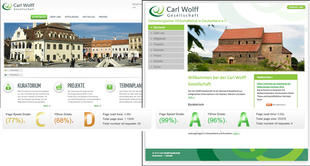Built for Speed
22 September 2013

In the early days of the WWW it was important to keep websites small and optimised because of bandwidth limitations. Now, with broadband connections, many designers don't bother with optimisation, but in fact it's still very important.
While your desktop computer may have cable internet, mobile users are often limited to 3G or shared Wi-fi which is much slower. Larger files also means more work for the browser in downloading, unpacking and caching.
Not too long ago, Google let slip that website load times were being factored into their search algorithm, which is another good incentive to pay attention to optimisation.
To the right you can see before and after screenshots of a website just redeveloped by Chirp. Overlaid are the PageSpeed and YSlow grades obtained from GTmetrix.
According to GTmetrix the new website is more than five times smaller in terms of file size and loads more than five times faster. The number of files that have to be downloaded has decreased from 59 to just 8, and that includes a fading photo slideshow.
A faster website means a better experience for your visitors, not just on mobile, as well as potentially better search rankings.
If your website is slow and getting slower you should contact Chirp to find out what we can do to make it better. You can also run your own speed tests using the GTmetrix tool linked below to find out where the problem lies.
Related link
« Office closed 19-20 September